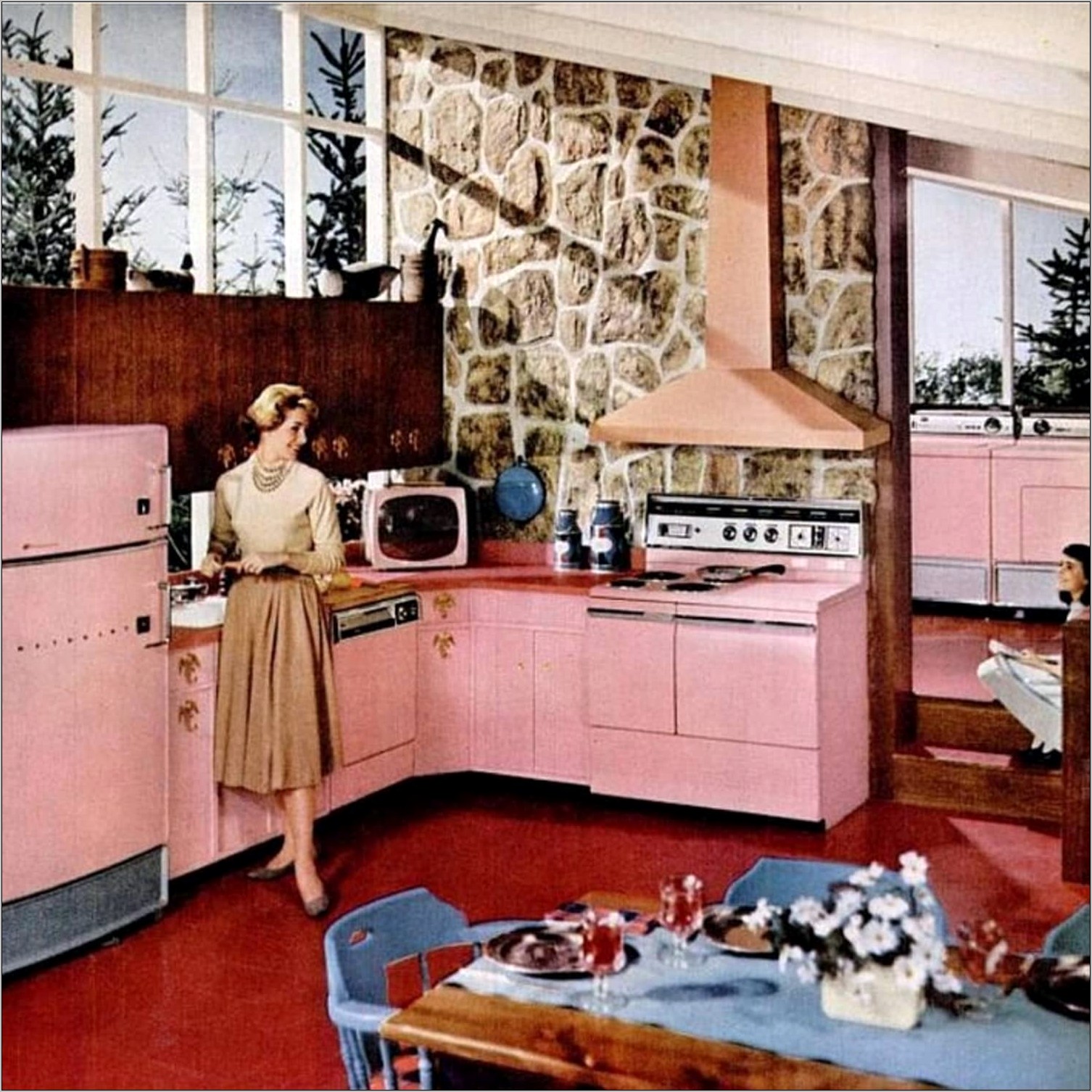Stepping Back into Style: The Essence of 1960s Kitchen Design
Hey there, style enthusiasts! Get ready to embark on a journey back to the groovy 1960s, where kitchens were bursting with color, innovation, and a playful spirit. Far from the sleek minimalism of today, these kitchens were a vibrant reflection of the era’s cultural shifts and design revolutions.
So, buckle up as we delve into the heart of 1960s kitchen design—uncovering the stories behind those unforgettable hues, exploring the game-changing appliances that promised to revolutionize home life, and rediscovering the bold patterns and materials that defined this iconic era. Whether you’re looking for vintage inspiration for your own modern home or simply curious about the fascinating evolution of kitchen design, this is your guide to outshining the competition with a fresh, insightful take on the 1960s kitchen.
Diving into the Details: What Made 1960s Kitchens Unique?
The 1960s were a time of radical change and a dramatic departure from the conformity of the 1950s. This transformative energy extended into the very heart of the home—the kitchen. Unlike the stark, utilitarian kitchens of previous decades, the 1960s kitchen was a celebration of personality, a fusion of futuristic dreams and handcrafted charm.
Key Takeaways:
- A Shift from Function to Form: The 1960s marked a pivotal moment in kitchen design. While new technologies like dishwashers were emerging, the primary focus shifted towards aesthetics, creating kitchens that were as stylish as they were functional.
- The Warmth of Wood: Out with the cold, industrial steel of the past—in with the warm embrace of wood! Affordability played a key role in this transition, making wood cabinets a popular choice and transforming kitchens into inviting spaces.
- A Kaleidoscope of Color: While avocado green might be the most iconic hue of the era, the 1960s kitchen palette was surprisingly diverse and sophisticated. Think sunny yellows, vibrant oranges, and yes, even pops of psychedelic pink—the bolder, the better!
- Space Age Dreams Meet Handcrafted Charm: The 1960s were a time of cultural fusion, and kitchen design reflected this beautifully. Sleek, Space Age shapes collided with handcrafted details, creating kitchens that were both futuristic and uniquely personal.
- Iconic Pieces: Imagine starburst clocks, Sputnik chandeliers, and hand-painted tiles, all coming together to create a look that was both playful and undeniably cool.
Beyond Avocado Green: What Were 1960s Kitchen Cabinets Made Of?
Stepping into a 1960s kitchen is like stepping into a time capsule of style. While practicality remained important, this era was all about infusing kitchens with personality and pizzazz. So, what exactly were those trendy cabinets made of? Let’s uncover the materials that defined the look of the 1960s kitchen:
The Reign of Wood:
- Natural Beauty & Affordability: Wood was the undisputed star of the 1960s kitchen. Maple, oak, and hickory were popular choices, prized for their durability, classic appeal, and affordability.
- Finishes: While stained and varnished wood cabinets were common, painted finishes (especially in lighter tones) also emerged, reflecting the era’s trend towards brighter, more vibrant kitchens.
Modern Alternatives:
- Melamine & Particle Board: For homeowners on a budget, melamine and particle board offered a sleek and modern look at a more affordable price point. These materials were also incredibly easy to clean, making them a practical choice for busy families.
- Plastic Laminates: The Heart of Retro Cool: If you wanted to inject your kitchen with a dose of futuristic flair, plastic laminates were the way to go! Available in an array of bold colors and groovy patterns, laminates were a hallmark of 1960s design.
Beyond the Materials: Design Elements That Defined an Era:
- Color Palettes: Warm earth tones like avocado green, harvest gold, and burnt orange were all the rage, creating a warm and inviting atmosphere. Pastels, carried over from the 1950s, took on a more vibrant and playful tone.
- Slab Doors: Clean lines and simplicity were key design principles, and slab doors (flat-panel cabinet doors) embodied this aesthetic perfectly. Their sleek, minimalist look added to the overall airiness and modernity of 1960s kitchens.
- Open Shelving: Some kitchens incorporated open shelving, allowing homeowners to showcase colorful dishware or decorative items. This design element added a touch of airiness and a more informal, personalized feel.
1950s Kitchens: Where Modernity Took Root
To truly appreciate the revolution of the 1960s kitchen, it’s helpful to understand the design landscape that preceded it. The 1950s, a time of post-war optimism and burgeoning consumerism, witnessed a dramatic shift in how kitchens were perceived and utilized.
Two Hallmarks Defined This Era:
-
The Rise of Modern Design: The 1950s marked the advent of “fitted kitchens”—standardized units designed for efficiency and a cohesive look. No longer simply utilitarian spaces, kitchens were embracing style and functionality in equal measure.
- The Work Triangle: This concept, still prevalent today, emerged in the 1950s. By strategically placing the refrigerator, sink, and stove in a triangular formation, kitchens were optimized for efficiency, minimizing wasted steps and maximizing workflow.
- Materials of the Modern Age: Durable, easy-to-clean materials like laminates, chrome accents, and vinyl flooring became synonymous with the 1950s kitchen, reflecting the era’s emphasis on practicality and sleek modernity.
-
Technological Advancements Transforming the Home: The 1950s ushered in a wave of new appliances that promised to revolutionize the way families lived and cooked.
-
The Rise of the “Must-Have” Appliance: Refrigerators, electric stoves, dishwashers, and garbage disposals were no longer luxuries but rather symbols of progress and a more modern lifestyle.
- Pastel Perfection: Appliances weren’t just functional; they were stylish! Pastel hues, from pale pink to mint green, added a touch of cheer and personality to the 1950s kitchen.
1960s vs. 1950s Kitchens: A Design Evolution
While both the 1950s and 1960s witnessed significant advancements in kitchen design, there were some key distinctions that set them apart:
- Color Palettes: While pastels were prominent in both decades, the 1960s embraced a wider range of hues, including bolder colors like avocado green, harvest gold, and shades of orange. The 1950s, on the other hand, leaned towards softer, more subdued pastel tones.
- Design Influences: The 1950s kitchen reflected post-war optimism and a desire for all things new and shiny. Chrome accents and sleek, streamlined designs were prominent features. The 1960s, influenced by the Space Age and a growing fascination with pop art, embraced bolder colors, geometric shapes, and a playful mix of textures and patterns.
- Materials: While both decades embraced new materials like laminates and vinyl, the 1960s saw a resurgence in the popularity of natural materials like wood. This shift reflected a growing desire for warmth and a more organic feel in the kitchen.
Inspired by the Past, Designed for Today
Whether you’re drawn to the retro-cool vibes of the 1960s or the sleek modernity of the 1950s, one thing is clear: These kitchens left an undeniable mark on the world of design. And their influence can still be seen in kitchens today. From the enduring popularity of open floor plans to the resurgence of colorful appliances, the kitchens of the mid-20th century continue to inspire and captivate.
Check out this amazing 1950’s mid-century modern house interior that will make you feel like you’ve stepped back in time. And if you’re a fan of the 1960s kitchen, you’ll definitely want to see this one.
- Best Foldaway Poker Tables of 2024: Buyer’s Guide & Reviews - April 22, 2025
- Greenhouse Storage Shed Combos: Your Guide to Combining Growing and Storage - April 21, 2025
- Greenhouse Shed Combo: Design, Build & Grow Year-Round - April 21, 2025










